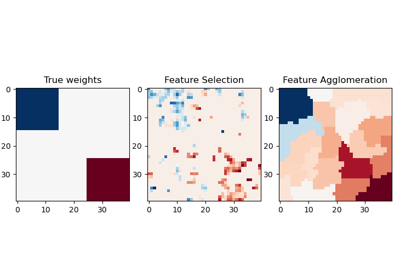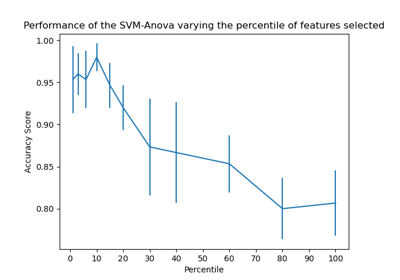sklearn.feature_selection.SelectPercentile¶
-
class
sklearn.feature_selection.SelectPercentile(score_func=<function f_classif>, *, percentile=10)[source]¶ Select features according to a percentile of the highest scores.
Read more in the User Guide.
- Parameters
- score_funccallable
Function taking two arrays X and y, and returning a pair of arrays (scores, pvalues) or a single array with scores. Default is f_classif (see below “See also”). The default function only works with classification tasks.
New in version 0.18.
- percentileint, optional, default=10
Percent of features to keep.
- Attributes
- scores_array-like of shape (n_features,)
Scores of features.
- pvalues_array-like of shape (n_features,)
p-values of feature scores, None if
score_funcreturned only scores.
See also
f_classifANOVA F-value between label/feature for classification tasks.
mutual_info_classifMutual information for a discrete target.
chi2Chi-squared stats of non-negative features for classification tasks.
f_regressionF-value between label/feature for regression tasks.
mutual_info_regressionMutual information for a continuous target.
SelectKBestSelect features based on the k highest scores.
SelectFprSelect features based on a false positive rate test.
SelectFdrSelect features based on an estimated false discovery rate.
SelectFweSelect features based on family-wise error rate.
GenericUnivariateSelectUnivariate feature selector with configurable mode.
Notes
Ties between features with equal scores will be broken in an unspecified way.
Examples
>>> from sklearn.datasets import load_digits >>> from sklearn.feature_selection import SelectPercentile, chi2 >>> X, y = load_digits(return_X_y=True) >>> X.shape (1797, 64) >>> X_new = SelectPercentile(chi2, percentile=10).fit_transform(X, y) >>> X_new.shape (1797, 7)
Methods
fit(X, y)Run score function on (X, y) and get the appropriate features.
fit_transform(X[, y])Fit to data, then transform it.
get_params([deep])Get parameters for this estimator.
get_support([indices])Get a mask, or integer index, of the features selected
Reverse the transformation operation
set_params(**params)Set the parameters of this estimator.
transform(X)Reduce X to the selected features.
-
__init__(score_func=<function f_classif>, *, percentile=10)[source]¶ Initialize self. See help(type(self)) for accurate signature.
-
fit(X, y)[source]¶ Run score function on (X, y) and get the appropriate features.
- Parameters
- Xarray-like of shape (n_samples, n_features)
The training input samples.
- yarray-like of shape (n_samples,)
The target values (class labels in classification, real numbers in regression).
- Returns
- selfobject
-
fit_transform(X, y=None, **fit_params)[source]¶ Fit to data, then transform it.
Fits transformer to X and y with optional parameters fit_params and returns a transformed version of X.
- Parameters
- X{array-like, sparse matrix, dataframe} of shape (n_samples, n_features)
- yndarray of shape (n_samples,), default=None
Target values.
- **fit_paramsdict
Additional fit parameters.
- Returns
- X_newndarray array of shape (n_samples, n_features_new)
Transformed array.
-
get_params(deep=True)[source]¶ Get parameters for this estimator.
- Parameters
- deepbool, default=True
If True, will return the parameters for this estimator and contained subobjects that are estimators.
- Returns
- paramsmapping of string to any
Parameter names mapped to their values.
-
get_support(indices=False)[source]¶ Get a mask, or integer index, of the features selected
- Parameters
- indicesboolean (default False)
If True, the return value will be an array of integers, rather than a boolean mask.
- Returns
- supportarray
An index that selects the retained features from a feature vector. If
indicesis False, this is a boolean array of shape [# input features], in which an element is True iff its corresponding feature is selected for retention. Ifindicesis True, this is an integer array of shape [# output features] whose values are indices into the input feature vector.
-
inverse_transform(X)[source]¶ Reverse the transformation operation
- Parameters
- Xarray of shape [n_samples, n_selected_features]
The input samples.
- Returns
- X_rarray of shape [n_samples, n_original_features]
Xwith columns of zeros inserted where features would have been removed bytransform.
-
set_params(**params)[source]¶ Set the parameters of this estimator.
The method works on simple estimators as well as on nested objects (such as pipelines). The latter have parameters of the form
<component>__<parameter>so that it’s possible to update each component of a nested object.- Parameters
- **paramsdict
Estimator parameters.
- Returns
- selfobject
Estimator instance.


